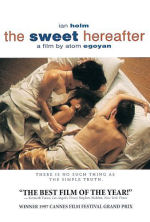|









|
 |
The Sweet Hereafter
(1997)
    
 |
Directed
by:
Atom
Egoyan |
COUNTRY
Canada |
|
GENRE
Drama |
|
NORWEGIAN TITLE
Den
søte ettertid |
|
RUNNING
TIME
112 minutes |
|
Produced by:
Atom
Egoyan
Camelia Frieberg |
Written by
(based on the novel by Russell Banks):
Atom Egoyan |
Review
Atom Egoyan's dissection of
the aftermath of a catastrophic school bus accident in a small town in
British Columbia, Canada is a slow-burning, bleak drama about the human
condition. Nuanced
characters and a realistic portrayal of mourning and vengefulness is
what makes The Sweet
Hereafter powerful and almost unbearable in equal measure. Egoyan is
unapologetic in his approach; he wants you to feel the characters'
despair and hopelessness. And he wants to shed light on the moral
ambiguity of the battle fought by our protagonist Mitchell Stevens (Ian
Holm). Like the members of the community he seeks out to help, he too has
lost a child in a way, and so his desire to place guilt and seek
redemption is also his own personal struggle. The film walks a fine line
between subtlety and insistence, but mostly falls down on the right
side. Egoyan lets his characters play it all out for him, and to the
degree it shakes you and spits you out, you don't feel the cynisism of
story, only of some of the characters we meet along the way, but you
certainly feel the toll. This is not movie-making for those seeking
entertainment or aesthetics; it's all about dramatic power. Ian Holm
finds the right tone for his performance – you cling onto the hope that
his moral compass is correctly aligned. Also with strong supporting work
from Sarah Polley and Bruce Greenwood. The Sweet
Hereafter won the Grand Prix of the jury at Cannes in 1997.
Re-reviewed:
Copyright © 11.11.2023 Fredrik Gunerius Fevang
Original review: Copyright © 30.05.2000
Fredrik Gunerius Fevang
|
|